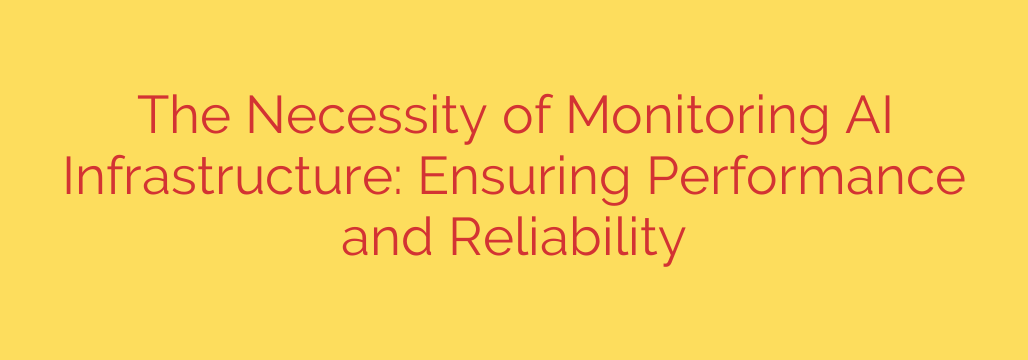
Beyond the Hype: Why AI Infrastructure Monitoring is Critical for Performance and Reliability
Artificial intelligence is no longer a futuristic concept; it’s a powerful engine driving innovation across every industry. From powering personalized customer experiences to enabling complex scientific research, AI systems are deeply embedded in core business operations. But as these models become more sophisticated and integral, a critical question arises: what happens when they fail?
Unlike traditional software, AI systems can degrade silently, with their performance eroding in ways that aren’t immediately obvious. A model that was highly accurate yesterday could be making flawed decisions today due to subtle shifts in data. This is where AI infrastructure monitoring becomes non-negotiable. It’s the essential practice of continuously observing, measuring, and managing the entire ecosystem that supports your AI applications, ensuring they remain reliable, efficient, and secure.
The Pillars of a Robust AI Monitoring Strategy
Effective monitoring goes far beyond checking server uptime. It requires a holistic view of the interconnected components that make an AI system function. Overlooking any single area can lead to performance bottlenecks, costly inefficiencies, or catastrophic model failure.
Here are the key areas you must watch:
- Hardware and Compute Resource Utilization: AI models, especially deep learning algorithms, are incredibly resource-intensive. Monitoring critical hardware like GPUs and CPUs is fundamental to prevent bottlenecks and control costs. Are your GPUs being used efficiently, or are they sitting idle while you pay for them? Proper monitoring helps optimize resource allocation, ensuring you have the power you need without overspending.
- Model Performance and Accuracy: This is the heart of AI monitoring. You must track core metrics specific to your model, such as accuracy, precision, and recall. More importantly, you need to watch for “model drift,” a phenomenon where the model’s predictive power degrades over time as it encounters new, real-world data that differs from its training set. Without drift detection, your AI could be making increasingly inaccurate decisions without anyone noticing.
- Data Pipeline Integrity and Quality: An AI model is only as good as the data it’s fed. It is crucial to monitor the entire data pipeline for anomalies, corruption, and changes in statistical properties. “Data drift” occurs when the input data itself changes, which can render a perfectly good model obsolete. Monitoring data quality ensures that your model’s inputs remain consistent and reliable.
- Operational Health: Latency and Throughput: For real-time AI applications, speed is everything. Monitoring latency (how long it takes for a model to make a prediction) and throughput (how many predictions it can make over time) is essential for a positive user experience. A sudden spike in latency can indicate underlying infrastructure problems or an inefficient model that needs optimization.
- Security and Compliance: AI systems process vast amounts of data, which often includes sensitive or personal information. Robust security monitoring is essential to protect against unauthorized access, data breaches, and adversarial attacks designed to manipulate model outcomes. This includes tracking access logs, monitoring for vulnerabilities, and ensuring the system adheres to data privacy regulations.
The High Cost of Flying Blind
Ignoring AI infrastructure monitoring is a significant business risk. The consequences can range from minor inefficiencies to complete project failure.
When you don’t monitor your AI, you risk:
- Degraded Performance: Your application may become slow or unresponsive, leading to customer frustration and abandonment.
- Flawed Business Decisions: A drifting model can provide inaccurate insights, leading to poor financial forecasts, misguided marketing campaigns, or faulty operational choices.
- Skyrocketing Costs: Inefficient use of expensive GPU resources can lead to wasted cloud computing budgets without delivering proportional value.
- Security Vulnerabilities: Unmonitored systems are prime targets for cyberattacks, potentially exposing sensitive company or customer data.
Actionable Steps for Effective AI Monitoring
Getting started with AI monitoring doesn’t have to be overwhelming. By implementing a few best practices, you can build a resilient and reliable AI ecosystem.
- Establish a Clear Baseline: Before you can detect anomalies, you must understand what “normal” looks like. Document the baseline performance metrics for your hardware, data, and models under typical operating conditions.
- Automate Alerting: Don’t rely on manual checks. Implement an automated alerting system that notifies the right teams immediately when a key metric deviates from the established baseline.
- Use a Unified Observability Platform: To get a complete picture, it’s vital to bring together logs, metrics, and traces from across your AI stack. A unified platform prevents data silos and allows for faster root cause analysis when issues arise.
- Prioritize Drift Detection: Actively implement tools and processes specifically designed to detect both model drift and data drift. This proactive approach allows you to retrain or update models before their performance significantly degrades.
Ultimately, AI infrastructure monitoring is not just a technical task for IT teams; it’s a strategic imperative for any organization leveraging artificial intelligence. It is the bedrock of a successful and sustainable AI strategy, providing the visibility and control needed to transform potential into reliable, long-term value.
Source: https://feedpress.me/link/23532/17172252/why-monitoring-your-ai-infrastructure-isnt-optional-a-deep-dive-into-performance-and-reliability







